The holy twin city, where echoes the Hare Krishna Hare Rama
This article may contain affiliate / compensated links. For full information, please see our disclaimer here.
If you want to get close to the spiritual side of India, include the temples of Mathura and Vrindavan in your itinerary of the Golden Triangle, which is only a couple of hours from Delhi and a few hours from Agra. Millions of pilgrims come to one of the holiest places of India, the birthplace Krishna. As a non-Hindu, you wonder why to visit so many temples here or anywhere in India. The answer is because they are fascinating, and none is similar to the other. The best time is to come during the Holi festival! Here you find all the information about the most famous temples in Mathura and Vrindavan.
How to go to Mathura from Agra/Delhi
Mathura is approximately 60 km from Agra.
- There are two ways to go with a car: National Highway 2 or the Yamuna Express Highway. The latter one is faster but is a much longer route. The Express Highway is a good option if you go from Delhi to Agra. But if you include Mathura, then it is better to take the old Highway.
- The train takes 40 minutes to one hour to Mathura. You can buy your ticket online here: https://www.irctc.co.in/nget/train-search. According to the class, you book the prices range 50 – 1500 INR.
- The fastest and most rewarding is to go on a one-day organized tour from Agra. In this way, you can get a deeper insight into what religion means for Hindus.
How to go from Mathura to Vrindavan
The easiest is to take an auto-rickshaw from Mathura to Vrindavan. The distance is only 10-15 km, and it takes 30 minutes with a cab.
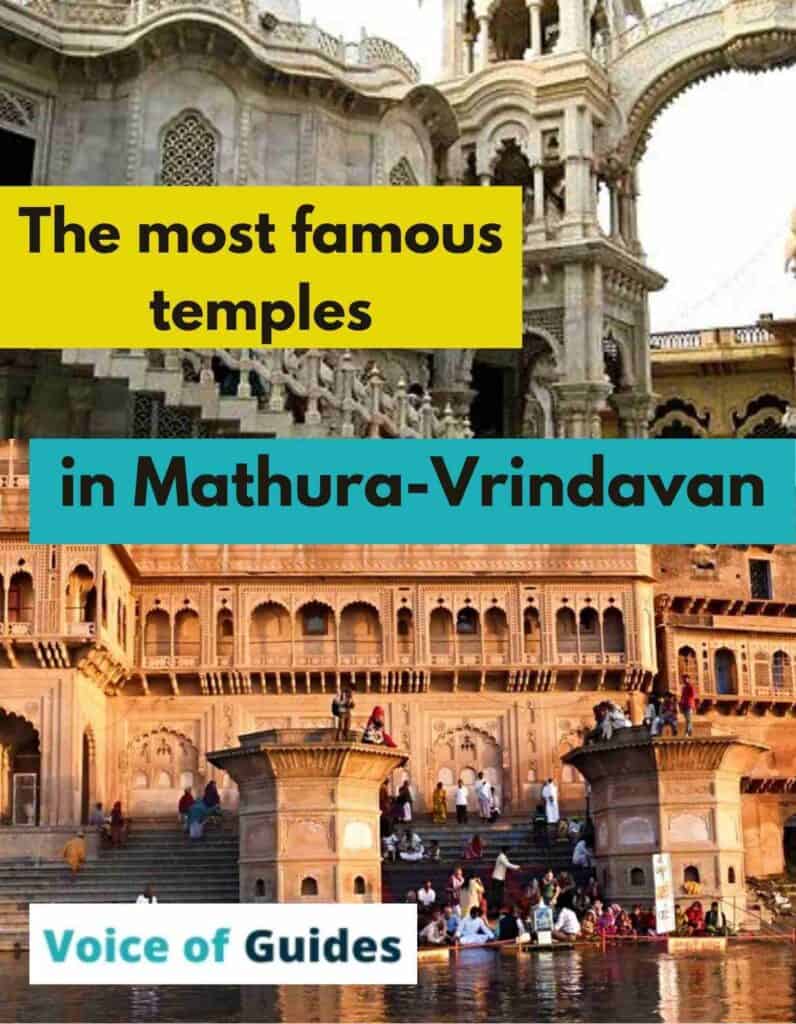
The story of Krishna in short
Mathura, Gokul, Barsana, Govardhan, and Vrindavan in the Braj region are all associated with Lord Krishna. Krishna was born in a prison cell in present-day Mathura. His uncle, King Kansa, was afraid of Krishna, as according to the prophecy, later Krishna would kill him. But Krishna miraculously managed to escape by the river Yamuna. His stepparents raised him in Nandgaon, then Krishna became a cowherd in Gokul and Vrindavan. Finally, the prophecy came true. Lord Krishna killed king Kansa and ruled Mathura for a long time before moving to Dwarka.
There are several stories of the young mischievous Krishna, who climbed everywhere to get his favorite yogurt. At the same time, he already killed demons as a child. Krishna often played the flute for the thousands of gopis (shepherdesses), but Radha was his greatest devotee and lover. Barsana is the hometown of Radha, the eternal love of Krishna. Krishna and Radha are inseparable and the symbol of heartfelt affection. The dancing Radha and Krishna often dance together on the wall paintings.
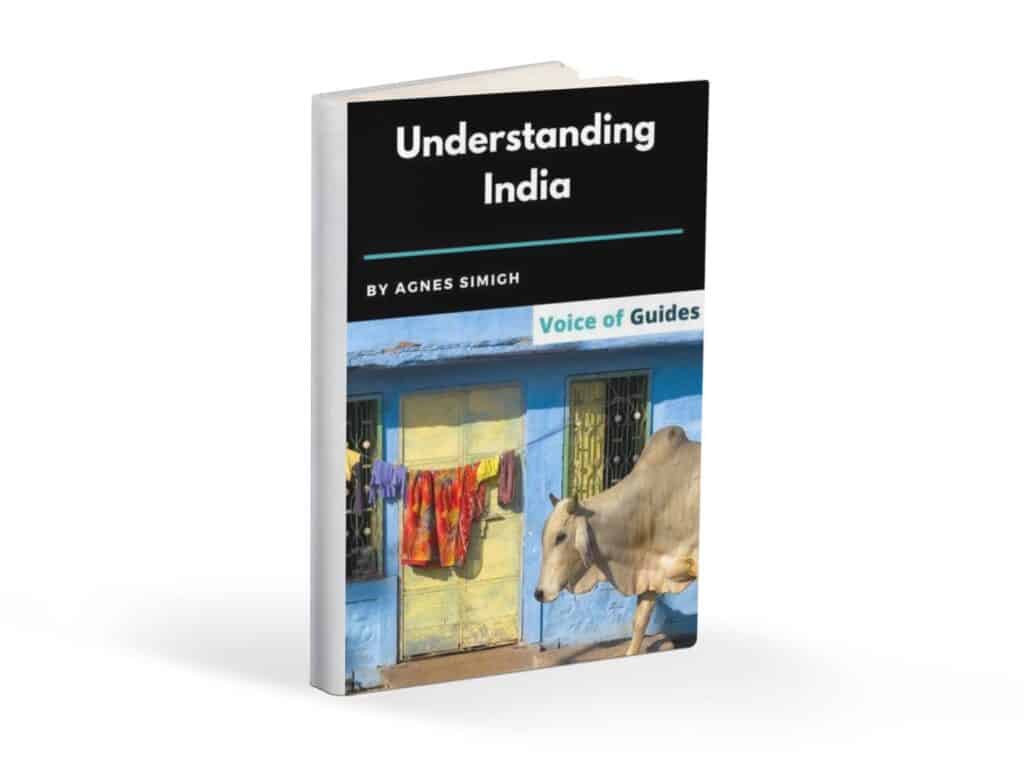
The Govardhan Hill
Another well-known story is when he lifted the Govardhan hill with his finger to protect the population of Govardhan from the devastating rainfall induced by the God Indra. Krishna was the one who convinced the people to disobey Indra, so he had to save them when Indra wanted to take revenge. During Govardhana puja, they build a mountain from food (halva, dhal, pakora, puri, sweet rice, rasgulla, etc.) as offering to Lord Krishna. After that, they distribute it among the people, and it will not get wasted.
Govardhan Parikrama – the circumambulation of the sacred hill
Hundreds of thousands of Hindu believers complete the Govardhan Parikrama (the circumambulation of the auspicious hill) every year. There are different ways to accomplish the 23km long pilgrimage. Some do it barefoot, carry a pot of milk in one hand and another with burning incense in the other hand. The milk pot contains a small hole at the bottom that marks the path of the pilgrim. Saddhus (holy men) prostrate themselves on the ground at every step, and thus for them, the parikrama can take several weeks or months.
According to the belief, those who circumambulate the hill in any way will get rid of all their sins.
Things to know before visiting the temples in Mathura-Vrindavan
- Always dress up modestly when you enter Hindu temples (cover your shoulder and knees)
- There is no entrance fee to Hindu temples but leave some small donation for the maintenance
- In the prominent temples, priests carry out daily aarti ceremonies to honor the residing God. It is a great time to observe the Hindu religious practices
- most Hindu temples open early morning and close late at night. But keep in my mind that they often close for some hours during the day
- You must remove your shoes before entering the temple. After your visit, you should give some tips to get back your shoes.
- Celebrating Holi, the festival of colors in Mathura, Vrindavan, Nandgaon, or Barsana, is a lifetime experience. Do not miss it when you are during this time in India.
- Sellers are often disturbingly pushy in Mathura. Get ready for that and remain patient.
I. The most famous temples in Vrindavan
There are more than 6000 temples (mandirs) for a total population of about half a million in the two cities. A spiritual place where temples are the most important sights.
Vrindavan, where Krishna spent his childhood, is a small town. You can wander from temple to temple just listening to the morning temple bells and the Hare Krishna Hare Rama chants. The devotees line up to give their offerings (garlands, sweets) to Lord Krishna, which they can buy from the small stalls. Vrindavan and Mathura are both located along the river Yamuna. The flights of steps (ghats) along the riverbank help the devotees to have a dip in the holy river. In the evening, the aarti, the religious fire ceremonies are a unique experience at the Ghats.
Many Hindus come here to renounce worldly life permanently. Generally, seniors seek to become sannyasis (or hermits) here. The town has plenty of ashrams and places where they guard numberless holy cows in Vrindavan. Being a sacred animal in Hinduism, they refrain from eating its meat. But they make use of their milk and the dried cow feces for cooking.
Here, destitute widows spend their lives in complete seclusion and live in great austerity.
Most tourists prefer to stay in Mathura and make a day trip to Vrindavan, as it has only a few hotels and a guest house at the ISKCON temple. Statues and posters of Krishna and Radha are on sale at every temple. These are popular gifts for relatives and friends.
The best two-week itinerary including the Golden Triangle
Banke Bihari temple – the main temple in Vrindavan
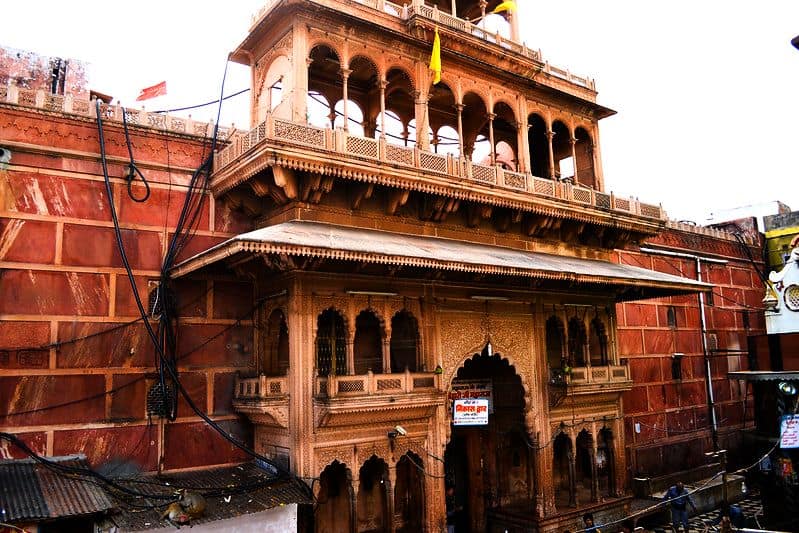
Banke Bihari is the main and one of the most visited temples of Vrindavan. At the same time, one of the richest due to the generous donations of devotees. Banke means „bent at three angles”, while Bihari means „supreme enjoyer”. It refers to the usual posture of Lord Krishna, with his right knee bent across the left one and the right hand holding the flute while playing the flute.
What makes this temple stand out is that devotees venerate Lord Krishna as a child. The religious ceremonies are also made in such a style as if nurturing a small child. Unlike other Hindu temples, Banke Bihari opens late to let child Krishna sleep after having played all night. There is no bell so as not to disturb Krishna. The priests hide the idol of Krishna after every minute because the charisma of the Lord is too strong. They believe that if one stares into the eyes of Krishna for a long time, this person loses his self-consciousness. The birthday of Krishna, the festival of ‘Janmashtami’ is celebrated spectacularly with plenty of flowers and lights that attract crowds of visitors every year.
Opening hours: every day 7:45 am – 12:00 pm; 5:30 pm – 9:30 pm
Nidhivan temple – where Krishna and Radha come to play every night
The most important and still somehow less reputed is the Nidhivan temple. Somewhat absorbed by the lush vegetation amid twisted trees and greenery, it houses the nicely decorated statues of Lord Krishna and Radha. There are several stories associated with this place.
They believe that Lord Krishna comes here every night and performs spiritual activities (Ras Leela) with Radha and the gopis (shepherdesses). They lock the temple in the evening so that Krishna and Radha could spend their time without being disturbed. According to the belief, anybody who tries to peek into the temple will turn deaf, dumb, and even blind. Nobody can disclose this secret of this temple.
The priest places toothbrushes, sarees, bangles, paan leaves, holy water, sweets, and a ready bed inside. The following morning everything is found scattered around as if somebody was using them. It seems they tasted the paan and the water. Therefore, after the evening aarti (religious ceremony), all windows and doors are kept closed till morning. Even animals are not allowed to approach and disturb the divine entertainment.
Lord Krishna lives in the temple! – according to Hindu belief
Another story of Nidhivan is that there is a rock in the temple area. Legend has it that Lord Krishna used to play hide and seek with his friends. Krishna used to hide behind this rock, where he left his footprints. Even the giant mountains melted down to rocks after hearing the sweet flute tunes of Krishna.
Bushy forests surround the temple, and strangely all trees are hollow and have twisted branches. Hindus say that these trees are not real trees. They are the ‘Gopis’ who come to life at night to perform the Ras Leela with Radha and Krishna.
Opening hours: during summer 5:00 am – 8:00 pm; during winter 6:00 pm – 7:00 pm
Rangji temple – unique for its South-Indian style
The 19th-century temple shows a strong South-Indian influence. The main priests are always South Indian Brahmins. The temple is famous for the Brahmotsava Festival celebrated for ten days after the Holi festival in March- April. The “Ratha Ka Mela”, when devotees drag a giant wooden chariot from the Rangji temple to its gardens and back, is the highlight of the festival. Thousands of devotees from nearby towns and villages come to watch the special illuminations of the temple.
Opening hours: every day 5:30 am – 12:00 pm; 4:00 pm – 9:00 pm
Govind Dev Mandir – looks like a cathedral
It stands out with its shape similar to the cathedrals of Europe. Some even wrongly suggested that a European architect commissioned in the 16th century to put up a temple with a church-style nave, transepts, and choir, all traditional parts of a cathedral.
Opening hours: every day 4:30 am – 12:30 pm; 5:30 pm – 9:00 pm
Prem Mandir – one of the biggest temples in India
The impressive shrine at the edge of Vindravan celebrates the love of Krishna-Radha and Rama-Sita. It took 12 years for 1000 artists to build one of the most expensive temples in India.
Opening hours: every day 8:30 am – 12:00 pm; 4:30 pm – 8:30 pm
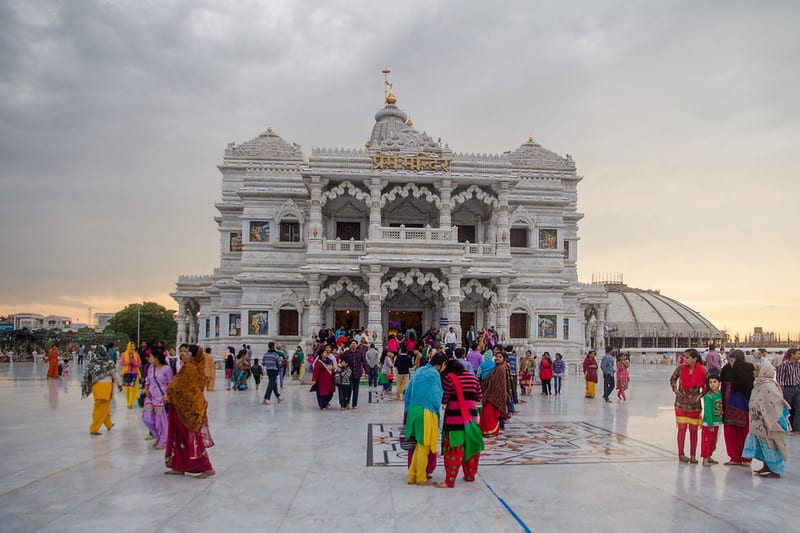
Radhavallabh temple
The RadhaVallabha religious sect has its chief sanctuary close to the Bankey Bihary temple. It is dedicated to Radha, the female companion of Lord Krishna. It seems odd that instead of the idol of Radha, they placed a crown next to Krishna to symbolize her presence. The temple plays a central role during the celebration of Radha’s birthday, the Radhashtami festival. The temple name reflects that Radha and Krishna are regarded here as “one soul in two bodies.”
Opening hours: 05:00 am – 09:00 pm
Sri Krishna-Balaram Mandir or ISKCON temple Vrindavan
The Sri Krishna Balaram is one of the principal ISKCON (International Society for Krishna Consciousness) temples.
Swami Prabhupada, the founder of the organization wished to dedicate it to Krishna and his brother, Balaram, who joyfully played together once in Vrindavan. The complex opened its doors for pilgrims in 1975. Apart from a decent guesthouse, there is a bakery, a souvenir shop, and a restaurant on the spot.
The Samadhi Mandir adjacent to the temple is the final resting place of Swami Prabhupada, whose white marble statue stands in the middle. You can visit the museum to learn about his teachings, missions, and activities.
Countless Krishna devotees gather here to follow the path of one of the most beloved Hindu Gods. Priests create a divine atmosphere with their chantings, the bell clangings as part of the daily aarti ceremony.
For that, it is a great experience to stay in the local guesthouse for the night.
Opening hours: summer: 4:30 am – 12:45 pm and 4:30 pm – 8:00 pm; winter: 4:30 am – 1:00 pm and 4:00 pm – 8:15 pm
Priyakant Ju temple – The lotus temple of Vrindavan
This temple attracts all the attention primarily due to the unique lotus leaves that surround the main shrine. Come here in the evening to see the temple in its best form with lights to understand why it is one the most beautiful temples in Brindavan.
Opening hours: Every day 6:00 am – 12:30 pm; 4:30 pm – 8:30 pm
Seva Kunj temple
According to Hindu belief, Krishna and Radha used to come to this place to spend time together. It has eye-catching wall paintings of the life scenes of Krishna and Radha.
Opening hours: every day 8.00 am – 7.30 pm (Closed between 11:00 am to 05:30 pm). Plan your visit to this temple during the day as they close the gates after sunset.
Shahji temple
The otherwise simple Shahji temple catches the eye immediately with its unusual architecture. A wealthy jeweler from Lucknow financed the construction of the temple in 1876. Twelve spiral columns adorn the façade of the white marble house of worship. The other highlight is the Basanti Kamra with Belgian glass chandeliers and stunning wall paintings that recall the life of Krishna.
Opening hours: 8:00 am to 11:00 am and 5:30 pm to 7:00 pm.
Vrindavan Chandrodaya Mandir – The brand new skyscraper temple for Lord Krishna
It is currently under construction, but it will be the tallest church on earth (213m) and probably one of the most expensive ever built. They estimate the total costs to 102 million dollars. It will be part of the religious organization, the International Society for Krishna Consciousness (ISKCON).
Incredibly, it has a deeper foundation than Burj Khalifa, the tallest building in the world. The religious complex will include four temples with an expansive green area decorated with musical fountains, waterfalls, lotus ponds, and lush vegetation. The temple will have a lookout tower with an elevator, from where visitors can enjoy the stunning view of Vrindavan and the Yamuna river. A skywalk will connect some remote parts of the temple, a Krishna theme park will welcome the children, and a night safari is also among the plans. Some new accommodation options will also be available.
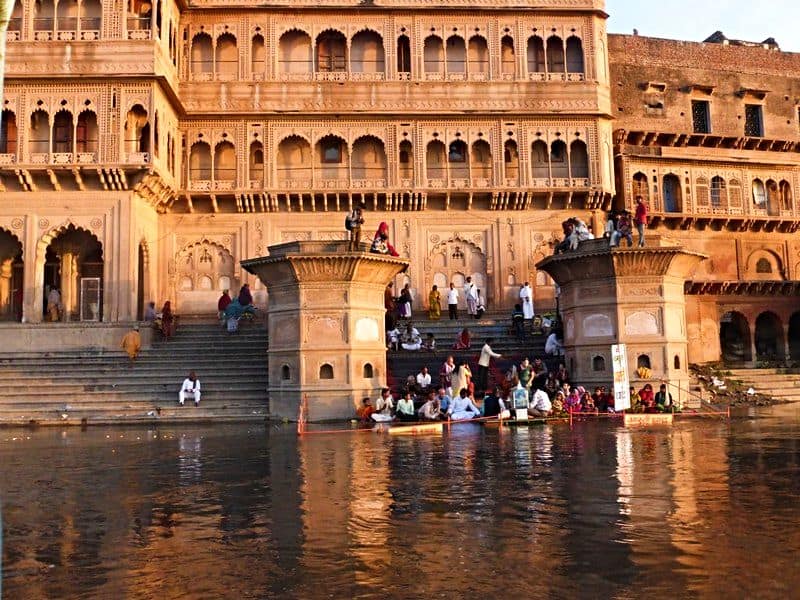
II. The best places to visit in Mathura
Mathura, one of the seven holy cities of India, lies at the riverbanks of the Yamuna. If you expect that a city of such religious importance is tidy, then you are wrong. Mathura is a shock for the foreign visitor especially compared to the green and tidy New-Delhi. Life seems to have stopped here. Crumbling houses and littered narrow alleys with poor-quality roads are a common sight in Mathura. Still, the birthplace of Krishna attracts crowds of Hindu pilgrims. Priests and Krishna devotees create a divine atmosphere where echoes the melody of “Hare Krishna, Hare Rama”.
Krishna Janma Bhoomi Mandir (Janmasthan Temple Complex)
Once there was a prison cell at this place, where baby Krishna was born. It is undoubtedly the holiest place of Mathura. The 20th-century complex includes several shrines, the replica of the prison cell, and the Keshav Deva temple in the center. Apart from Krishna and Radha, other important Hindu Gods are also present. The vibrant paintings of the ceiling depict the dancing Krishna and Radha. Different rulers destroyed the temple several times. Last time the Mughal Emperor, Aurangzeb, and built the adjacent Shahi Idgah on its ruins. Therefore, Hindus believe that the mosque is the old Keshav Deva temple.
It has given ground for ongoing conflicts between the Hindu and Muslim communities in Mathura. In 1967 the court of Mathura ruled that the mosque will stay intact next to the temple. But Hindus do not give up on that and keep on filing pleas to have the mosque removed.
When you approach the temple, you see that armed soldiers watch over the security. Since 1992, when the Hindu devotees attacked and damaged the Babri mosque in Ayodhya, the Hindu-Muslim tensions have intensified. Hindus claimed that Lord Rama was born where the Babri mosque stands now. There was a Hindu temple once there, and they wished to get access to pray that the Muslims always denied.
It is the best place to visit in Mathura during Janmashtami when they celebrate the birth of Krishna and Holi festival.
Tip: Be careful with the monkeys around the temple. They may steal your glasses or food if you do not pay attention.
Entry restrictions: The security at this temple is tight due to the above. You are not allowed to take a camera, mobile and other electronics, leather products, and bags with you. There is a locker at the entrance to deposit your belongings, but it is better not to take anything with you.
Opening hours: 5:00 am-12:00 pm and 4:00 pm – 9:30 pm (in summer)
5:30 am – 12:00 pm and 03:00 pm- 8:30 pm (in summer)
Gita Mandir or Birla Temple – the tidiest temple in Mathura
The Birla family gave a generous donation to construct a temple in Mathura. The mix of red and creamy-colored sandstone gives it a similar look to the Birla temple in New Delhi. It stands out with its modern design among the otherwise shabby shrines of the twin-city. The main shrine houses the white marble statue of Lord Krishna.
During the Janmashtami festival, the temple looks fascinating with beautiful flowers and light decoration.
Opening hours: 05:00 am to 12:00 pm and 02:00 pm to 08:00 pm.
The best two-week itinerary for your first visit to India including the Golden Triangle
Sri Dwarkadheesh Mandir
It is a must to visit one of the oldest and largest temples of Mathura, the Sri Dwarkadheesh mandir. Dwarkadheesh means the „King or God of Dwarka”, which is another reference to Krishna. After leaving Mathura, Krishna spent the rest of his life in Dwarka. Lord Krishna appears as a black marble idol in this mandir.
On his side appears his eternal love, Radharani, made of white marble. The Maharaja of Gwalior from the Scindia family gave a significant donation for the construction.
The temple plays a central role during the most important Hindu festivals: Holi, Diwali, and Janmashtami. It is custom that they shift the idol inside a “Hindola” (a type of swing set) when the monsoon comes.
The Sri Dwarkadheesh mandir stands near the Yamuna River, and you can easily reach it with an autorickshaw in 10 minutes or a cycle rickshaw in 15–20 minutes only.
Opening hours: summers 6:30 am – 10:30 am and 4:00 pm- 7:00 pm, winters 6:30 am – 10:30 am and
3:30 pm – 6:00 pm.
Vishram ghat – holy dip and floating oil lamps and aarti ceremony
Once you are at the Dwarikadhish temple, continue to walk to the most prominent Ghat of Mathura, the Vishram ghat. It occupies a central position among the 25 ghats. Vishram means „rest”. According to the mythology, Krishna had rest at the Ghat after killing the tyrant Kansa, as foretold by the prophecy. Pilgrims take a ritual bath early morning in the holy Yamuna water and wash away all their sins.
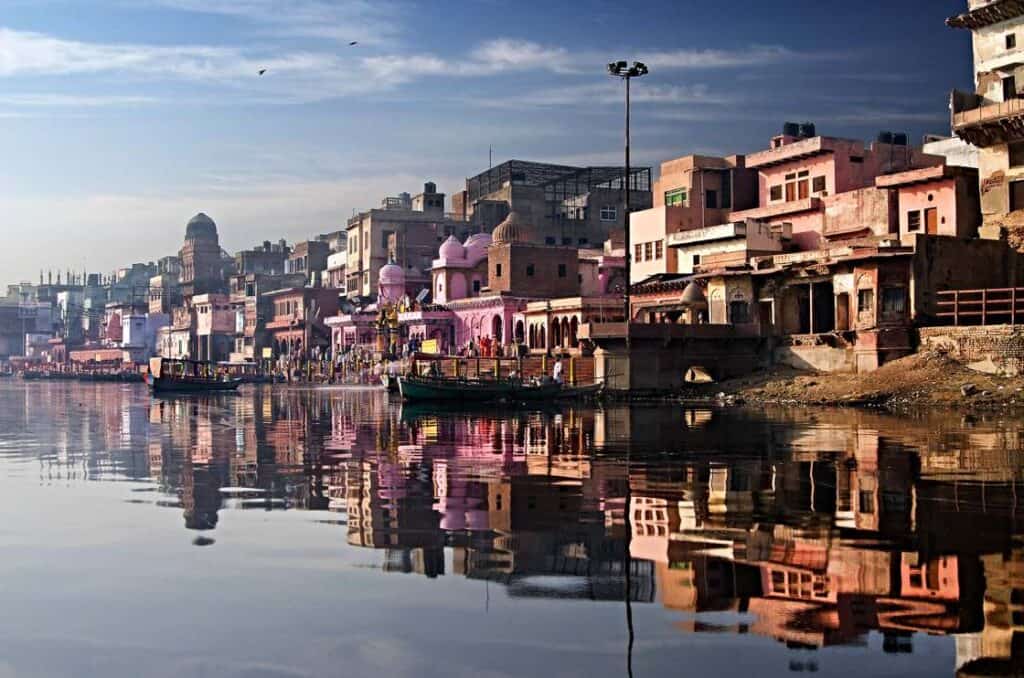
It is the starting and finishing point of the traditional parikrama when pilgrims visit all the holy places in Mathura.
The evening time is the best time to come to the Vishram Ghat when they perform the daily aarti ceremony.
Tip: take a boat ride in the evening to see the hundreds of oil lamps floating on the river surface and watch the aarti ceremony.
Important: Be careful with the monkeys at the Ghat, and avoid local priests and touts who offer to perform prayers and rituals.
Aarti timings: summer: 7:00 am to 7:15 am and 7:00 pm, Winter: 6:45 am to 7:00 am, Evening: 7:00 pm
Jai Gurudev temple and ashram
It is impossible to miss the temple along the Delhi-Agra highway with its striking domes and measures similar to the Taj Mahal. Locals know it as Naam Yog Sadhna Mandir. It is one of the places to visit once you are in Mathura. Everybody is welcome to have a quick look, or to stay longer and learn about the teachings of the respected holy man.
The temple has a weird restriction and refuses any gift and donation from non-vegetarians.
Jai Gurudev was a saint with many followers and tried to show them the way to eternal life. He lost his parents as a child and followed a spiritual path from a young age. Later he set up his ashram. Jai Gurudev died in 2012 at an estimated age of 116. Surprisingly, his private driver inherited his estimated fortune of $ 2.5 billion.
In the 1980s and 1990s, he joined politics, but his aim to get into the Indian Parliament was unsuccessful.
How to plan your trip to India
Book your flight ticket to India: I always use Google Flights, Skyscanner or Wayaway to find the cheapest flight tickets worldwide. To get an extra 10% for your Wayaway Membership Plus program use my discount code VOG
Insurance to India: Safetywing is an affordable insurance that covers COVID-related issues as well.
: Book your train, bus and domestic ticket in India:
Check Indian Railways website for train tickers, or 12Go which gives you the best option (train, bus, and flight) based on the city of departure or arrival.
Book accommodation in India: Booking.com and Hostelworld.com offer a wide choice of low and higher-budget hotels.
Local tours and tour packages: Viator and GetYourGuide offer transfers and several one or multi-day tours.

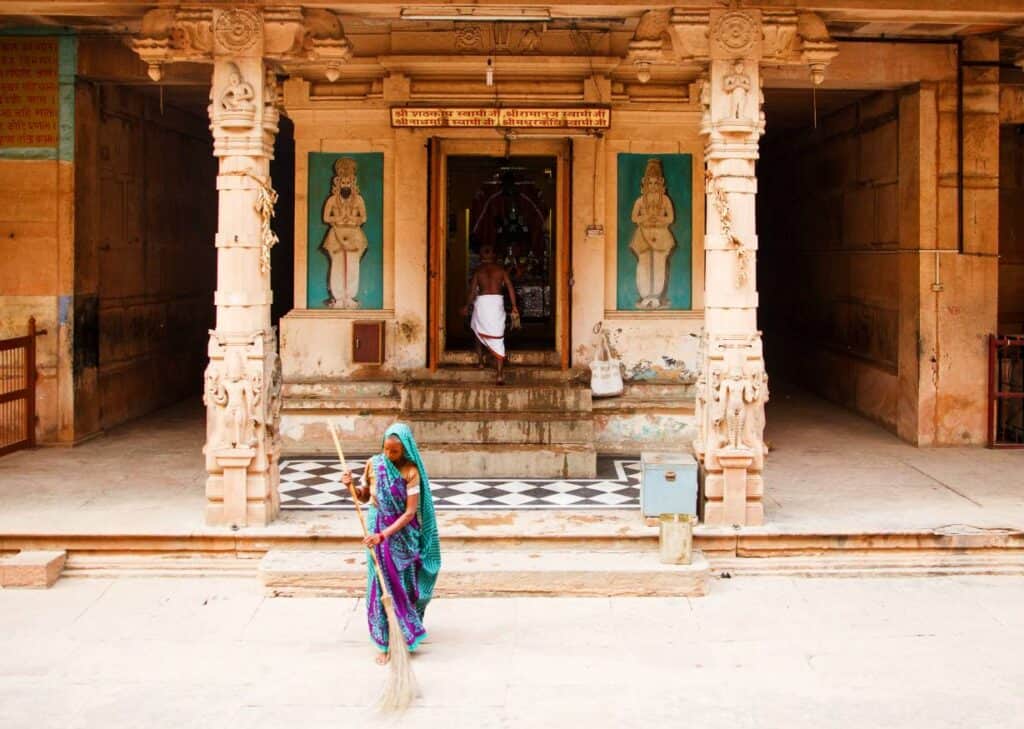

Pingback: How to celebrate the Holi festival in Mathura-Vrindavan | Voice of Guides